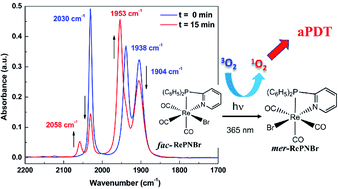Photochemistry of P,N-bidentate rhenium(i) tricarbonyl complexes: reactive species generation and potential application for antibacterial photodynamic therapy†
Abstract
In this work, we describe the photoisomerization of facial rhenium(I) tricarbonyl complexes bearing P,N-bidentate pyridyl/phosphine ligands with different chelating rings and anions: RePNBr, RePNTfO, and RePNNBr, which are triggered under irradiation at 365 nm in solutions. The apparent photodegradation rate constants (kapp) depend on the coordinating ability of the solvent, being lowest in acetonitrile. The kapp value increases as the temperature rises, suggesting a reactive IL excited state thermally populated from the MLCT excited state involved. Using the Eyring equation, positive activation enthalpies (ΔH≠) accompanied by high negative values for the activation entropy (ΔS≠) were obtained. These results suggest whatever the P,N-ligand or anion, the reaction proceeds through a strongly solvated or a compact transition state, which is compatible with an associative mechanism for the photoisomerization. A 100-fold decrease in the log10 CFU value is observed for E. coli and S. aureus in irradiated solutions of the compounds, which follows the same tendency as their singlet oxygen generation quantum yield: RePNBr > RePNTfO > RePNNBr, while no antibacterial activity is observed in the darkness. This result indicates that the generation of singlet oxygen plays a key role in the antibacterial capacity of these complexes.



 Please wait while we load your content...
Please wait while we load your content...